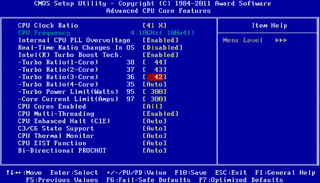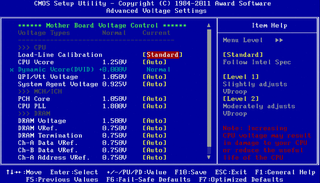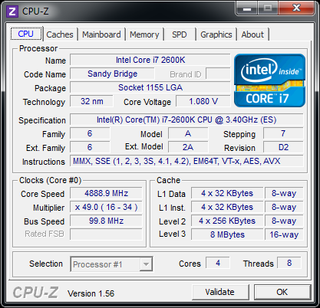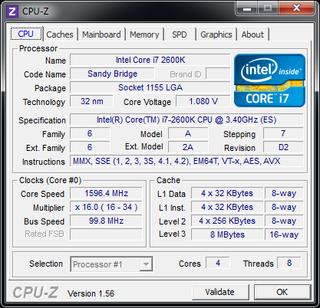Core i7-2600K Overclocked: Speed Meets Efficiency
Most of Intel's Core i5 and i7 CPUs lock out overclocking enthusiasts, which we hate. But the K-series chips win us back over with insane scalability. Would you believe that cranking the dial on performance doesn't necessarily tank overall efficiency?
Overclocking Settings

We decided to gradually increase the default multiplier, starting with the 34x default, but stay with the default Turbo Boost ratios, as described on the previous page. This means that our Core i7-2600K processor accelerates by four 100 MHz speed bins as long as the power limit allows. So, we went all the way from 34+4 to 46+4.
We also moved the power limits up to 300 W for our overclocking project, because we wanted to check out the limits based on Intel’s boxed cooler. The unit that comes with the K-series processors can be considered at least solid and, will probably be used by most users buying a K-series processor.
However, our extreme power limit paired with this cooler certainly doesn’t protect our system from crashing at high clock speeds. This is because the cooler inevitably hits its thermal limits and because the power unit won’t govern clock speeds at our effectively unlimited power limit. The cooler bundled with the K-series processor is adequate for reasonable overclocking. Hardcore users might want to shop for a more powerful device, though.

These are the voltages we selected for our overclocking project:
| Clock Speed | CPU-Z Voltage | BIOS Voltage | |
|---|---|---|---|
| Row 0 - Cell 0 | 4-Core | 1-Core | Row 0 - Cell 3 |
| 3.5 GHz 4-Core; 3.8 GHz 1-Core | 1.176 V | 1.224 V | 1.25 V |
| 3.7 GHz 4-Core; 4.0 GHz 1-Core | 1.236 V | 1.224 V | 1.305 V |
| 3.9 GHz 4-Core; 4.2 GHz 1-Core | 1.26 V | 1.224 V | 1.345 V |
| 4.0 GHz 4-Core; 4.3 GHz 1-Core | 1.26 V | 1.224 V | 1.35 V |
| 4.1 GHz 4-Core; 4.4 GHz 1-Core | 1.272 V | 1.224 V | 1.35 V |
| 4.2 GHz 4-Core; 4.5 GHz 1-Core | 1.272 V | 1.224 V | 1.35 V |
| 4.3 GHz 4-Core; 4.6 GHz 1-Core | 1.284 V | 1.224 V | 1.355 V |
| 4.4 GHz 4-Core; 4.7 GHz 1-Core | 1.272 V | 1.224 V | 1.365 V* |
| 4.5 GHz 4-Core; 4.8 GHz 1-Core | 1.32 V | 1.272 V | 1.365 V* |
| 4.6 GHz 4-Core; 4.9 GHz 1-Core | 1.332 V | 1.284 V | 1.37 V* |
We used Gigabyte’s P67A-UD5 motherboard for our overclocking testing and left the voltage settings on Auto mode for almost all clock speeds except 4.4, 4.5, and 4.6 GHz (*).

This was the fastest reliable setting on our Core i7-2600K sample. Multiplier 45x with up to four speed bins in Turbo Boost mode for a single core. The voltage reading isn’t accurate, though.

All Sandy Bridge processors currently switch to 16x (1600 MHz) when idle.
Stay On the Cutting Edge: Get the Tom's Hardware Newsletter
Get Tom's Hardware's best news and in-depth reviews, straight to your inbox.
One final note: the Core i7-2600K processor always managed to maintain one multiplier above the configured default setting, which means that you will only see a difference of three (instead of four) speed bins in all benchmark charts.
Current page: Overclocking Settings
Prev Page Turbo Boost 2.0 And The PCU Manage Overclocking Next Page Test Setup And Benchmark Settings